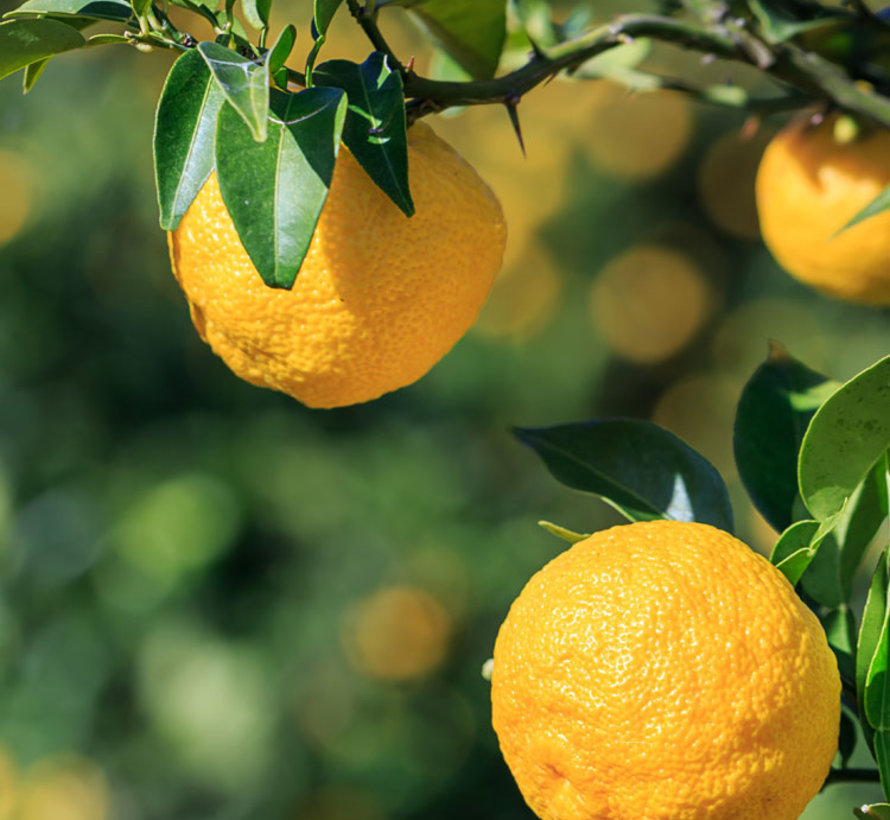Yuzu tree large
Be aware: please read the notes below at "Shipping"
These trees are grafted onto Citrus trifoliata 'Flying Dragon' rootstock. This makes the plant disease resistant, and it is reasonably hardy to -5ºC degrees.
The trees are suitable for growing indoors or outdoors in pots. After two years after purchase, they can also be planted in the garden. They flower in spring and, depending on the weather, produce yuzu fruit within two years.
Rapid and extreme temperature changes can cause the flowers and fruits to fall off too soon. The yuzu fruits are ripe between October - December. All trees have a length between 100-120cm (including pot) and were grafted at least 18 months ago.
For trees that are kept outside, we recommend planting them in a pot for the first two years and placing them in a sheltered place in the winter and protected from frost. Then plant the tree in the garden in the spring. In addition, we recommend protecting the tree against severe frost for the next 3 years e.g. by wrapping the tree.
The yuzu tree is a hybrid between a sour tangerine and the lemony Ichang papaeda. Yuzu is the one best known of the Japanese citrus fruits, the taste and aroma is a combination of grapefruit and mandarin. The skin of the fruit is very aromatic. Yuzu is an essential seasoning in Japanese cuisine and is used as an additive in Japanese ponzu, soy sauce and miso. Chefs use both the juice and the skin in dishes with fish, white meat, as well as in sorbets, ice cream and cocktails.
Yuzu Grow Guide
Planting
Plant the tree outdoors in a sunny, south-facing, sheltered spot. Provide loose soil. Clay soils should be mixed with sand to allow for proper drainage. Water once or twice a week in dry conditions. The yuzu tree does not like constant wet feet.
In a pot, use free-draining compost, extra perlite or bark to improve drainage. Repot the plant every 1-2 years.
Caring
To promote growth and health, we recommend feeding citrus or olive tree. If you choose a liquid variant, you will administer food more often. Granules need to be administered less frequently. Apply granules in the spring and again in the summer. These are the period when the plant is most active.
The most common pests are aphids and mites. Natural enemies will be sufficiently present in a garden with many other plants. In addition, you can spray the plant with water and a few drops of dish soap if these pests get too out of hand.
If flowering starts well in the first two years, it is recommended to remove some of the smallest fruits so that the remaining fruits are more likely. The first and second year normally around 12 fruits arrive.
Watch out for the sharp spines. These can be removed if they pose a hazard.
Trees can sprout below the point where they were grafted. These must be removed for optimal growth.
Harvesting
Very fragrant, small white flowers appear with spring. In this summer fruits appear that are green at first and then turn yellow in color after year. Just in time for fresh yuzu at Christmas dinner.
The fruits are ripe when it is bright yellow. Dark spots on the skin are normal and are also a sign that they are ripe. The unripe green fruits also fall off. These have a more acidic taste but are also great to use. The peel of both ripe and unripe yuzu is added to soups, dressing, cocktails and used as a topping for sushi and fish. You can also freeze the peel and juice for later use.
Shipping
We only ship these tree to The Netherlands, Belgium and Germany. For wholesale orders, please contact us.
The trees are trimmed before shipping. The trees are then carefully shipped in a large plant box. However, it is possible that a branch may break. Don't worry, the tree will produce new shoots within a few months."
These are large trees and are therefore sent with a separate DHL shipping service. This usually offers the package twice. If it is not possible to deliver the package in these two times, it will be returned. Most pickup locations will not accept the package.







